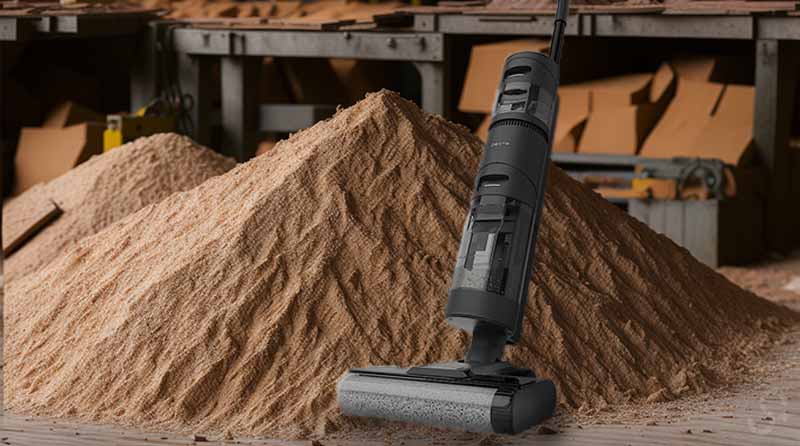When I first started tackling home improvement projects, I didn’t always have access to the right tools for the job. So I understand the allure of using any readily accessible vacuum to clean up after woodworking. I’ve mucked up enough vacuums to know if you’re doing a big project that’s going to produce a lot of sawdust, then you better use a vacuum that can handle it.
Key Takeaways:
It is generally OK to vacuum sawdust if the quantity of sawdust is less and if it’s not done frequently. For regular sawdust cleaning, it’s best to use a commercial grade or shop vacuum with robust build quality, high suction power, and larger dust collecting compartment.
Keep reading to discover how safe vacuuming sawdust is, especially with regular vacuums. Also, read on till the end to hear my recommendations for the best vacuums to clean your workspace effectively.
Is It Safe for Regular Vacuums to Pick Up Sawdust?
Generally, it is safe to vacuum sawdust with vacuums, especially with commercial-grade vacuums that are built for such purposes. However, with regular vacuums, although it is fine to vacuum sawdust, there are some risks, like filter clogging or motor damage.
The vacuums used in our home for daily usage are usually consumer-grade vacuums typically made for home cleaning tasks. They can efficiently clean dust, dirt, and spills depending on the type of vacuum you use. Regular vacuums are also effective for hard floors, carpets, wooden floors, and more.
There is another type of vacuum that is mainly used in shops – known as shop vacuums or commercial vacuums. These vacuums are usually more heavy-duty and can be more effective in cleaning the sawdust and other particles generally found in shops or other heavy dust-prone workspaces.
Now here’s the thing:
Most regular vacuums, as long as they are of good build quality and not entry-level ones, should be able to vacuum sawdust. But there are some potential risks associated with it.
First things first, regular vacuums are not designed to vacuum sawdust specifically. If it’s used occasionally to vacuum sawdust, then it’s OK. But regular usage can easily clog the vacuum’s filter.
The fine sawdust particles can get inside the filter pores, essentially blocking the system. So you will have to frequently clean or replace the filter of your vacuum, to allow it to function effectively.
Next, usually, in a woodworking workspace, there could be a high quantity of sawdust. And your regular home vacuum may not be able to work correctly with that amount.
The bag of the vacuum will get filled with dust and debris quickly. As a result, you must constantly keep emptying the bag to ensure the vacuum functions smoothly.
Issue Of Electricity And Ensuring Safety
Now, no matter what type of vacuum you use to vacuum sawdust, it is vital to consider the risk of electricity and fire hazard.
When the sawdust particles are vacuumed, inside the vacuum, they can rub against the surface of the vacuum cleaner material. This friction of particles can lead to static electricity.
Although if you are cleaning only a small amount of sawdust particles, this shouldn’t be a big issue. However, when vacuuming large quantities of sawdust, there will be a hazard risk because of the static electricity production.
What’s the solution then? Well, the electricity system in your work area should be properly grounded. And this means you need to install a grounding wire so that whenever you use the vacuum, the produced static electricity can go away inside the earth, keeping your work area safe and secure.
Drawbacks of Using a Regular Vacuum to Pick Up Sawdust?
It is OK to vacuum sawdust with a regular vacuum if it is done only occasionally. I do not recommend regular usage with a regular vacuum to clean sawdust because of the filter clogging issues.
I highly suggest purchasing a dedicated commercial vacuum to keep your work area clean.
For instance, you can also get a vacuum with a cyclonic separator chamber. The cyclonic separator would remove sawdust before the dust-filled air reaches the filter.
Just like its name sounds, a cyclonic chamber creates a cyclone effect inside the vacuum where dust-filled air moves at high speed.
The heavy particles of sawdust tend to be pushed to the sides of the chamber, and as a result, they fall and get collected in a separate bin. The relatively cleaner air, which is free from sawdust particles, now moves further towards the filter for filtration of dust from the air.
What Type Of Vacuum Is Suitable For Sawdust?
The most suitable vacuum for sawdust cleaning is the commercial grade/shop vacuum cleaner. They are made more durable, heavy-duty, and have more dust-holding capacity (so you don’t have to worry about frequent emptying of the bin).
The best thing is commercial vacuums are made for commercial settings, so they are more capable of cleaning sawdust or other dust particles present in the workspace.
Also, commercial or shop vacuums have bigger-sized hoses than regular vacuums.
Craftsman Heavy Duty 16 Gallon Shop Vacuum
Check the current price here (on Amazon)
If you’re looking for the best vacuum for cleaning sawdust, I recommend checking out the Craftsman heavy-duty 16-gallon shop vacuum. Here’s a quick rundown.
What I Like:
- It’s a heavy-duty vacuum with 6.5 hp ensuring that all dust particles including sawdust are easily vacuumed from your work area.
- This vacuum is also suitable for a garage or any outdoor setting where you want clean leaves, thanks to its blower port feature.
- My favorite thing about this vacuum is its suction power. Although regular vacuums are good at collecting dust, shop vacuums like this just take the vacuuming experience to the next level.
- I also like that a longer hose and cord are provided with this vacuum, allowing an easy cleaning experience in larger spaces.
What I Don’t Like:
- It would have been great if the cord holder was a bit bigger. Sometimes, it feels challenging to place all the cords in the cord holder properly.
- It is a big-sized heavy-duty vacuum, so the bulky design may not be suitable for small spaces.
Why It Is Suitable For Sawdust Cleaning:
Shop vacuums like this Craftsman 16-gallon have a heavy-duty design, large size compartments, big hoses, and high suction power. These tick all boxes required for a good quality vacuum that can easily vacuum sawdust. You will not get this experience with regular vacuums.
Now if you’re looking for something more automated, then you should consider a robot vacuum that’s built for shops. Check out robot vacuums like Makita DRC200PT or the Makita DR300Z. To see a detailed review of them, check out this guide about the best robot vacuums for workshops.
What Is The Other Way To Clean Sawdust?
One of the best ways to clean sawdust from any surface is by using a Tack cloth. A tack cloth is simply a type of wiping cloth that is prepared in a way to pick up loose particles from any surface.
If you don’t have a tack cloth, you can also use a damp microfiber cloth. So to effectively remove sawdust from any surface, all you need to do is just slightly wipe it over the affected areas. You can make a couple of passes to ensure the cloth picks up all the sawdust from that surface.
Also, be sure to keep the cloth in check. Once you notice that the cloth has absorbed too much dirt, it’s time to replace it with a new cloth.
Conclusion
In short, it’s totally fine to vacuum small quantities of sawdust with a regular vacuum, once in a while. However, for consistent and large-scale sawdust cleaning, it is important to use a heavy-duty shop vacuum like the Craftsman vacuum we saw in this post.
And no matter what type of vacuum you use, it’s essential to keep in check all the safety measures like grounded wiring to avoid any unwanted hazards in the work area.
Finally, if you are looking for alternative options, you can also use a tack cloth or damp microfiber cloth to clean the sawdust.








